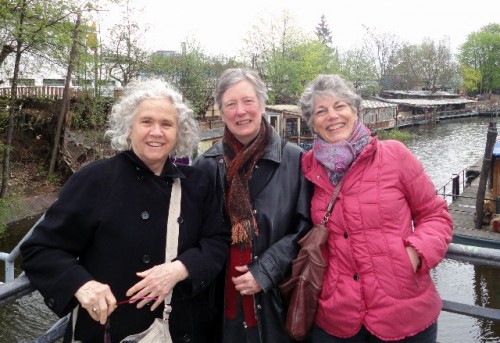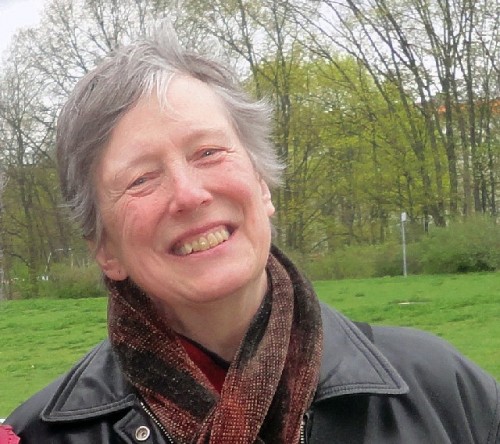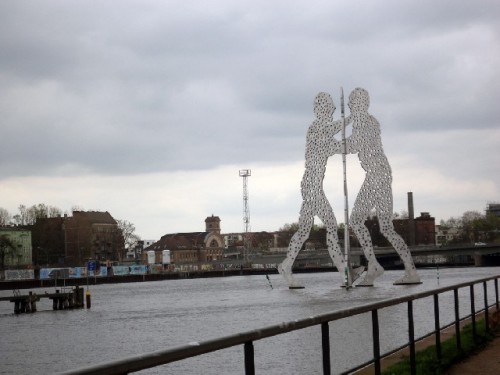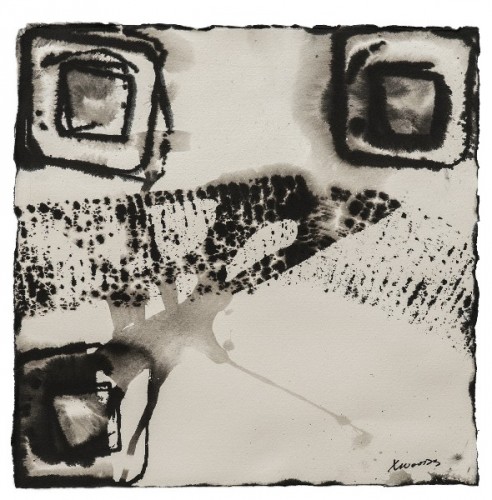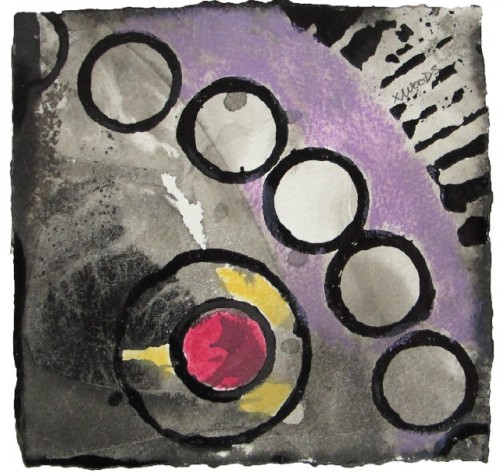Second Berlin Letter X Bonnie Woods
Artist Compares Boston and Berlin
By: Patricia Hills - Jun 29, 2013
When I got to Berlin in April, I looked up the artist Bonnie Woods who was staying here. I’ve known Bonnie for about 30 years—ever since we were both actively involved in the Boston Chapter of the Women’s Caucus for Art. In recent years she has spent considerable time in Germany, where her family lives. I was grateful to have a “go to” friend who could fast-track me into the manners and customs of Berliners. She taught me the very useful word for “tap water”—Leitungswasser—which is what one asks for if one doesn’t want expensive mineral water (mit Gas). Waiters, I’m saying, are no different in Berlin than in Boston, when they want to enhance the bill. She also introduced me to Kreuzberg, which is my neighborhood as well.
I was struck by her enthusiasm for both Berlin and Boston, so we sat down and talked. We followed up the conversation with emails. Her remarks offer a splendid comparison of the two cities—Berlin and Boston—and what they have to offer artists and the rest of us. Back in Boston she had a recent show at the Atlantic Works Gallery, at 80 Border Street in East Boston.
Patrica Hills : When and why did you first begin to come to Berlin?
Bonnie Woods: My first visit was in 1967 as a college student. I had minored in German, but it was German literature rather than conversational German. Suddenly in Berlin I was fascinated by being able to speak in another language, even in a limited way. It was a kind of coming of age.
I was also astounded that I was able to communicate with other people whose second language was German. I remember meeting a group of Russian students. The only language we had in common was German, and somehow it all worked out fine. Then I also discovered that I could do totally adventurous things because the language door was opened. Outlandish things.
PH: Were German artists important to you when you were an art student?
BW: One of my art heroes at the time was Karl Schmidt-Rottluff, one of the great “Die Brücke” artists. I think he was the last of those artists still living and right here in Berlin. I looked up his name in the phone book and went to his apartment. A brash, gutsy, rude American, clueless about German customs, I rang the doorbell. But he and his wife Emy let me in and were completely gracious. I look back on that now, and it still amazes me. He gave me a tour of his studio and I stayed for a couple of hours. He was old and frail. I often couldn’t understand his dialect, but Emy spoke some Hochdeutsch, and between the three of us, we could get by.
That was my introduction to Berlin. It was a place where I was adventurous. I always wanted to come back, especially after the Wall came down, but it was many years later – in 2000, when I had family living in Berlin and a place to stay – that I finally came back again.
PH: Why Berlin? Rather than another large German city, such as Hamburg or Munich?
BW: I lived one summer in Hamburg. It reminds me of Boston – lots of water around it, with a big industrial harbor and sailboats. I also spent quite a bit of time in Munich when I was studying in Salzburg. Munich was a fairly easy hitch-hike from Salzburg. Both are great cities.
But Berlin is Berlin. In many ways it is like a separate country, unlike the rest of Germany. I’m not sure I would like living in another big German city. It’s not that I want to live in Germany so much as I just want to be in Berlin.
PH: It sounds like your Berlin sojourns have an effect on your psyche and sense of well being.
BW: Berlin is also perhaps the gay and lesbian capital of Europe. I feel at home here. Much of where one settles is accidental. But if there is any part of it that depends on choice, one would choose to live where one feels most at home. Feeling at home for me means being able to be inside my art as well as in the world. That seems easier for me to do in Berlin than in many other places I’ve lived.
PH: How does Berlin affect your art?
BW: It feels like I have a quantum leap every time I am back in Berlin. And it is never planned. Last year, for example, I was invited to illustrate a Festschrift for the Univ. of Chicago press. The book was in honor of John Huehnergard, one of the foremost scholars of Near Eastern Languages, formerly at Harvard, now at U. Texas, Austin. [See http://oi.uchicago.edu/research/pubs/catalog/saoc/saoc67/ ]
I did over a hundred hours of – what to call it, visual research? – at the Pergamon museum, just looking at all the cuneiform I could find. Then I incorporated it into the illustration design for the book, and then it later crept into my studio work and large paintings.
Similarly, with photography, I seem able to make leaps here without really trying.
In Berlin I have some studio space limitations that I don’t have in Boston. I often need a lot of water for rinses for the paintings, and a big space where I can get messy. This is easier in my backyard in Chelsea. So in Berlin, I have to work on a smaller scale but it is okay. I do studies or smaller works on paper that will fit in my suitcase, or I work on folded paper, or I fill up sketchbooks with the beginnings of things. So there is a blur between what I make in Berlin and what I make in Boston.
In terms of making photos, that is a little more portable. But again, there is a sense of respect that I feel in Germany. People actually prefer black-and-white work on fiber paper, and since that’s what I do, it is a nice surprise to be appreciated. All of my b&w lab work, though, is now done in Boston by Chris Ofria, with whom I’ve been working for years.
This year I have made another big technical leap in Berlin, this time with color. We’ll see where that goes.
PH: Can you tell us how the current breakthrough came about?
BW: A friend and neighbor of mine in Boston, Michael Limberakis, died suddenly in March of this year. It was so sad; he was young, fit and active -- a kind and happy guy. He was a stained glass artist and artisan. I could not attend any of the memorial services because I was far away. So I decided to make a small study for a painting in his memory, full color, using some Swiss crayons I had in the studio. (I had bought the crayons for visiting children.) This small study was a wild take-off on a stained-glass motif.
I did more and more of these little pieces; I couldn’t get my fill. Soon there were about 50 of them. I have an exhibition coming up in Boston in June [Atlantic Works Gallery, East Boston, from June 6 – 30]. I think I’ll have the space to include a good number of these small “Designs for Michael.” They are each somewhere between a painting, drawing, and a monoprint, with repeating linear shapes in the dense sumi and the bright panes of solid color.
PH: Is it easy for American artists to move into the art scene in Berlin?
BW: It’s hard to know exactly what “art scene” means here. I mean, the visual arts, music, theatre, dance, etc., are so much more integrated into everyday life in Berlin than they are in the U.S. It’s more that you breathe it rather than go to it as a destination.
And I think, for an artist from America, one of the most surprising things here is that an artist is given much more respect. You are a welcomed and respected part of the society. Doing important work. Making a worthwhile contribution to the world. Unfortunately, this feeling happens only rarely in the U.S., in my opinion.
There are so many museums and galleries in Berlin that it is almost overwhelming. Because of the former Wall, there emerged at least two separate sets of everything. Even opera houses. There are now three different opera houses in Berlin! Many museum collections were consolidated or re-organized when the Wall came down, but no one wanted to give up the cultural spaces, so all those spaces were just filled with new culture. I will never probably see everything there is to see here. But somehow, that is also okay.
PH: Is it easy for American artists to show in the Berlin galleries?
I’m not sure. I have had some luck in some cultural institutions rather than in galleries. Knowing the language is a big plus. It’s only recently that I’ve gotten more interested in showing with a gallery. I was about to start showing at the Galerie Ben Kaufmann, but then he decided to close the gallery on fairly short notice. It was a big disappointment for many people, including artists. Including me. But he is making a documentary film now, and I’m sure it will be as surprising as his work as a gallerist.
PH: Have you been able to collaborate with other artists when in Berlin?
BW: I am just getting interested in collaborating more with other artists, but I think that is more about me than it is about Berlin, because I am wanting to do this more in Boston now, too. I find the artist groups in East Boston and Chelsea especially intriguing right now, with an activist edge to them that I like, so I am gradually getting more involved and social.
In Berlin I do find that I enjoy talking with artists who are coming from a completely different direction, say theatre people or circus people. For several years I’ve been getting together once a month with a group of former East German circus people. I am not really “collaborating” on anything with them, but I think my work is somehow influenced by them although I can’t really say how.
PH: Tell me about your involvement with the Holocaust remembrance project We Were Neighbors. I saw it on view at the Schöneberg Rathaus and was deeply moved.
BW: There is a fascinating Jewish history project in the Schöneberg area of Berlin, We Were Neighbors, based on the lives of the Jews who lived in this part of Berlin during the 1930s and 1940s and what happened to each individual during that time. The project is ongoing, and has been put together by historians, writers, and artists who do not want those individuals and that dark time of Germany’s history to be lost. They are producing books with photos, letters, and texts about each individual who was killed or forced to move from the area because they were Jews or people otherwise engaged in political and cultural activities against Hitler. Then these books are available to the public, in a beautiful public reading room at the Schöneberg City Hall.
So, for example, there is a book about a well-known person such as Walter Benjamin or Albert Einstein, but then those books are next to other books about everyday people who were cut off in their prime, or artists who were not allowed to show their work. Or writers who could not publish. It’s about the neighbor who was living next-door, who disappeared one day. And, of course, the project is indirectly but quite obviously also about the people who were left, who said nothing against the Nazis, and who passively let it all happen.
In any case, the We Were Neighbors project is now at the point where they are beginning to translate the books from German into English, and I’ve been invited to help with the translations. I can do that long-distance from Boston, too. You asked about collaboration with artists in Berlin. I don’t think this is exactly the sort of collaboration you meant, but this is a project that many artists and writers work on in Berlin, and it is one that I know is important and something that I want to spent time on.
PH: It sounds like you are really motivated by the possibilities of collaboration.
BW: Other Berlin collaborations I might mention. I continue to be fascinated by the possibilities opened by the Internet, and have only begun to push those borders. For example: In the past few years I’ve had an unusual collaboration with a poet from Chicago, Donna Pucciani. Donna and I first met when we were both teaching at a small Midwest college many years ago, and we had offices next to each other.
Since then, we’ve both gone on to other things, but we have always stayed in touch even though we have not actually seen each other in person for years. Donna’s husband is from England, so they spend much of their time there. By email she and I have been working together on projects and getting things published in poetry journals. I send her a photo, and she writes a poem based on it. Or she sends me a poem, and I send her back a photo. So far we have had luck getting “our” work published in 17 venues. One of our recent collaborations – a set of photos and poems about my Berlin neighborhood – was published in Wonderbooks Poetry, an online journal based in Macau, a Chinese peninsula in the South China Sea.
http://wonderbookofpoetry.org/donna-pucciani-and-bonnie-woods-photo-poem-collaboration-berlin/
Except for my documentary black-and-white photo work, I have had a longstanding aversion to realism. I think it comes from having worked as commercial illustrator for many years when my daughter was young. In the illustrating job, I had to make hyper-realistic drawings, day in and day out, in order to earn a lot of money fast. I came to hate that job.
Donna would rather work with more “realistic,” suggestive images, so this collaboration nudges me back toward realism, but in a kindly way. I have also had an aversion to digital photography, and in the beginning I would make digital scans of black-and-white analog images to send to her by email attachment, but the process was too unwieldy and expensive for me. I had to begin doing some digital work.
When we first worked at that college in the middle of Ohio, before we had even thought about having access to personal computers and the internet, we would have never even dreamed of collaborating between England and Germany, and between Chicago and Boston, on a project that would be produced in the Republic of China and made available to the world at large. It never would have even entered our minds! It would have seemed absurd and impossible, something out of Star Trek, “beaming up” our work here and there from one part of the world to another.
But now, who knows what will be possible, even by next year? I think artists need to stay open to these new adventures, and see where we can each best add to the cultural context of the world, or to our own backyard neighborhoods. I’m learning that there is a fine line between the world and our own backyard, even though they can sometime seem galaxies apart.
PH: What is your favorite museum in Berlin? Second favorite? Why?
BW: My favorite by far is the Pergamon, because it is unlike any other museum I’ve ever seen. My second favorite is a toss-up. I can spend hours in the Bodemuseum just looking at wood sculpture by Tillman Riemenschneider. I can go see the Rembrandts at the Gemäldegalerie. I can see what’s up at the Martin-Gropius-Bau. The Berlinische Galerie in a great place to see new and old art from Berlin. There are excellent photo galleries in Berlin. Some are quite specialized.
PH: What is your favorite neighborhood? Why?
BW: I love Kreuzberg, where I’ve lived for over 12 years now. It’s a place where, at one time, the artists and gays and revolutionaries gravitated. That tradition seems to be ongoing, but now Kreuzberg is also the area where most of the Turkish population have been living for 2 or 3 generations. There are mosques and Muslim cultural centers everywhere. So, I find it a rich mix of cultures, and one that I miss when I’m back in Boston.
PH: What other cultural events do you like to attend in Berlin that are not available in Boston?
BW: Well, Berlin is full of surprises. For example, last summer a friend took me to an outdoor café just across the canal from Museumsinsel. You can sit there at a table and sip a glass of wine, while before you is an outdoor dance floor, and single people and couples come from all over -- with their appropriate shoes and dress -- to dance Tango. Hard to picture in Boston.
I go to more theatre and films in Berlin than in Boston. The tickets are less expensive generally, and the variety greater. I can see many Hollywood and “independent” U.S. films here, but I rather like seeing films that I would never be able to see in the U.S. – Not just German language films, but also French, Asian, African, Scandinavian, Middle Eastern. I know many of these films will probably never get into the U.S. market.
In February comes the “Berlinale,” a major international film festival. Once you figure out the ticketing process, you can get tickets for 7 or 8 Euro. Here, too, I try to see things that I’d never even see in the regular Berlin film theatres. The Berlinale can be a big mind-expander, seeing so many different points of view, and putting the U.S. into some sense of world context.
I like the Café culture in Berlin. One can sit all day in a café with one cup of coffee, read a book, read all the newspapers and magazines in the café, write letters, an so on, and no one hassles you. This is partly because of tradition here, but also because of the way the wages are set up for the café workers. It seems there is no particular financial advantage to them if there is a fast turnover of customers; in fact it seems they would rather have the regulars in house rather than the fly-by tourists that they’ll never see again. It is just a different way of thinking that is totally “foreign” to Americans.
PH: Do you hang out with Americans or Germans when in Berlin?
BW: I try to stay away from Americans in Berlin. No offense. But there are probably thousands of Americans living in Berlin now, and one could feasibly live 24/7 speaking only English here, and that is really not what I want to do. One of the big things I want to do in my lifetime is speak at least one other language besides English well. Many Germans want to practice their English, too, and you have to be careful about that. You just have to keep barging ahead and speaking German with them, and they will switch back to German.
PH: When you return to Boston, what do you miss most about Berlin?
BW: Berlin friends, but also many other things listed here that I miss about Berlin, and in no particular order:
Deeper sense of history and culture – it pervades everything.
My senses always seem wide open in Berlin.
Living in a different language. (Seems somehow to jumpstart my brain.)
Excellent public transportation.
Healthier lifestyle with more walking.
More respect for artists.
Better life for gays and lesbians.
Safer for a woman to walk around alone at night. No fear of guns.
Fresher vegetables in winter.
More music in the streets.
“Greener” energy awareness.
Museums and galleries everywhere, not limited to one area of town.
Less expensive concerts, theatre, film.
More international awareness.
My constant re-evaluation of my personal and political choices. Nothing is on “automatic pilot.”
Bicycles everywhere.
The sound of cars driving over cobblestones.
PH: Would you care to elaborate on other favorite things about Berlin?
BW: In Berlin I do find that I enjoy talking with artists who are coming from a completely different direction, say theatre people or circus people. For several years I’ve been getting together once a month with a group of former East Berliners.
In both places, friends go to the top of the list of what I miss most about one city or the other. And the ease of being back in the respective “home” neighborhood, whether Boston or Berlin. We friends stay in touch by email, but that kind of connection is qualitatively different from sitting down together, face-to-face.
In Berlin, I live in a quiet place – on a garden courtyard that is abutting an old church with stained-glass windows 6 stories high. Lots of trees. Lots of birdsong. But otherwise there is a profound quiet.
PH: What about Boston and your living situation there?
BW: In Boston, I live in the Chelsea waterfront neighborhood, on the Boston Harbor. I also have a big garden and lots of trees, but the everyday sights, sounds, and smells could not be much more different.
Being in Chelsea, on a working harbor, I can see large ships slowly moving past, and the big drawbridge going up and down. Sailboats, tugboats, oil tankers, container ships. When I am in Berlin I miss the smell of the saltwater sea breeze and sounds of the seagulls in Boston.
There is a daily sense of commerce and motion in this part of Boston: proximity to Logan Airport and overhead airplanes, Tobin Bridge car traffic, Boston Harbor ship traffic and tugboat whistles, drawbridge horns, nearby commuter rail station and sounds of train whistles, sirens from nearby police and fire stations, traffic helicopters overhead, general sense of flux and constant buzz of commerce. In an odd way I “miss” this noisy place. It fuels me up. I get caught up in the inertia of all this activity.
PH: What else about Boston do you love and miss when you are in Berlin?
BW: I miss my gardens and garden design projects. I think a lot about those gardens when I am in Berlin. Oddly enough, the birdsong in Berlin and Boston is completely different, and the sound of Boston birds is still more familiar to me. More homey, less exotic.
Activist projects in my Chelsea neighborhood. I recently received a grant through the Boston Foundation, to make a new illustrated color map of Chelsea. This is hard to work on when I am in Berlin.
PH: Anything else about Boston?
BW: Spanish-speaking cultures in my neighborhood. Having full command of the language (English). TV. Proximity to large bodies of water. I am within sight of Boston Harbor, and the Atlantic Ocean is only a few minutes away. (In Berlin I live on the canal way that circles the city and connects up with the Spree River.)
My own back porch overlooking one of my gardens.
Working in large format with an outdoor water source.
New England seafood.
New England birdsong.
And also: My car. Jumping into my car and just driving. Being able to transport things in my car. But walking on the streets and along the canals of Berlin is a pleasure.
PH: You truly have a rich full life, and we have not even discussed your travels in Europe outside of Berlin. That will be another day. Until we meet again: Many thanks and “auf wiedersehen.”
Professor Patricia Hills teaches American Art at Boston University. She is the author of numerous books and exhibition catalogues for the Whitney Museum of American Art and other museums.
John F. Kennedy-Institut für Nordamerikastudien
Freie Universität
Lanstraße 7-9
14195 Berlin

